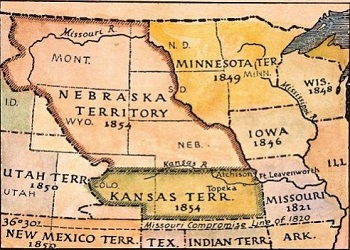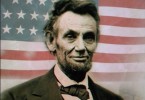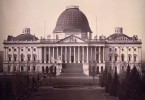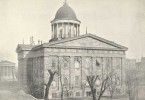What is the Kansas-Nebraska Act?
On May 30, 1854 Congress passed the Kansas-Nebraska Act proposed by Illinois Democratic Senator Stephen Douglas and by President Franklin Pierce. The act organized governments on territory that belonged to the Louisiana Purchase, Kansas and Nebraska, these new territories would be open to decide on the inclusion or exclusion of slavery by popular sovereignty. The Kansas-Nebraska Act nullified the 1820 Missouri Compromise which served as a limitation on the spread of slavery.
Anti-slavery and pro-slavery supporters rushed to Kansas to impact the outcome of the elections. Anti-slavery supporters held elections but were charged with fraud by pro-slavery settlers. When elections were held by pro-slavery supporters, anti-slavery settlers refused to vote. This led to two administrations being established in Kansas and the ensuing violence which is known as “Bleeding Kansas”.
Abraham Lincoln committed himself to build a coalition against the Kansas-Nebraska Act. He enlisted Democrats critical of Douglas’ proposal.
Lincoln and Douglas Debates
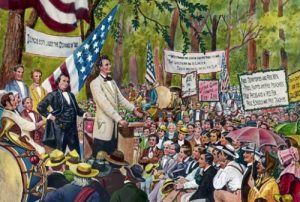
The seven Lincoln-Douglas debates, also known as the Great Debates of 1858, took place during a race to the Senate. The main issue discussed during the seven debates was slavery.
The Lincoln-Douglas debates were a series of 7 debates between Abraham Lincoln, the Republican candidate for the US Senate for the state of Illinois and Stephen Douglas, the Democratic Party candidate. The main issue at hand was slavery in the United States. The seven debates were held in each of the nine congressional districts of Illinois. Two, in Springfield and Chicago, had already taken place individually so they both agreed on joint debates on the rest of the districts.
- Ottawa on August 21
- Freeport on August 27
- Jonesboro on September 15
- Charleston on September 18
- Galesburg on October 7
- Quincy on October 13
- Alton on October 15
The audience in the first debate in Ottawa was described as intelligent and attentive. Lincoln’s goal was to make the distinction between slavery in existing states, a right guaranteed under the constitution, and the expansion of it, an unconstitutional move. He carefully studied the national history concerning the expansion of slavery. He noted that from the 1789 Northwest ordinance, to the 1820 Missouri Compromise and the Compromise of 1850, all of which had recognized the right of Congress to exclude slavery from new territories. He claimed that the latest territories included in the Union, Minnesota and Iowa, were organized within the restriction of the Missouri Compromise and that there was no need this time to repeal it.
He disputed Stephen Douglas’ argument that slavery would not expand into new territories as their populations might or might not vote for it. However, the slavery sentiment in Kansas was flourishing.
Stephen Douglas argued that Americans had the right to self government and that restriction of slavery had to be removed so that residents could decide on their own. This argument was strongly refuted by Lincoln. He centered his argument on the question of “whether the negro is not or is a man”. Lincoln argued against Stephen Douglas’s claim who viewed the African-American not as human but as a piece of property. As a result of this view Douglas did not consider it a moral dilemma enslaving and limiting the freedom of a human being. Lincoln asserted that the Declaration of Independence was the core of American freedom based on the fact that all men are created equal.
Lincoln addressed the slavery issue with a tone of moral outrage that impressed his audience. He denounced Douglas’ claim that the Founding Fathers permitted self-government in the new territory as heresy. He added that American slavery should be seen in world perspective; America should be the example of human freedom based on the success of its Union.
Abraham Lincoln’s address was remarkable, for nearly 3 hours he refuted Douglas’ claims and made an impression on the audience. Douglas offered a rebuttal that lasted nearly 2 hours.
His speech was essentially the same as in the Springfield debate but this time he put it in writing and was published in the Illinois State Journal with the purpose of reaching more people.

